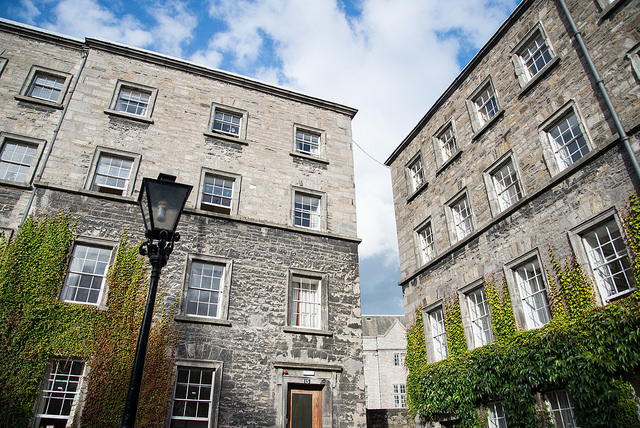Over recent months, the reality of Dublin’s accommodation crisis has hit home once again as students have struggled to find accommodation for the year. Indeed, it is evident that the crisis has deepened, with a report released in August finding that the number of rooms available to rent in Dublin was down by 350 on 2015 levels and that prices had risen by 10 per cent in the city over the same period.
Speaking to The University Times, the report’s author, Prof Ronan Lyons, an assistant professor in Trinity’s Department of Economics, described the situation in the capital as “pretty bleak”. Lyons explained: “Student numbers are going up, the broader population is growing and the fraction renting is increasing. So the demand for rental accommodation is very high and only going up, but the supply hasn’t really increased. There is basically no new apartments that have been built in Dublin on any meaningful scale in the last eight years.”
As policy-makers and interested parties seek to get to grips with the crisis, approaches to student accommodation in other European cities have received increased attention.
Among the creative solutions that have been tested on the continent is shipping containers repurposed as student housing, a phenomenon that has appeared in several cities
President of the Union of Students in Ireland (USI), Annie Hoey, speaking to The University Times, said that the union was at the “earlier stages” of delving into research regarding approaches taken in other countries. Explaining the rationale for this undertaking, Hoey explained: “I think other European cities are useful to look at, in terms of, some of them have really creative solutions. These solutions may not work here, but they certainly put us in a position to start thinking a little bit outside of the box, in terms of what is currently being done and trialled here in Ireland.”
When looking for alternative housing, there are not a lot of solutions out there. Among the creative solutions that have been tested on the continent is shipping containers repurposed as student housing, a phenomenon that has appeared in several cities including Amsterdam, Berlin and Stockholm. Indeed, a Danish company, Urban Riggers, has gone further, creating an eco-friendly student accommodation complex of containers on a concrete pontoon, floating in Copenhagen’s harbour, powered by solar panels and with hydra-source heating.
Hoey acknowledged the limits to exploring solutions used elsewhere in an Irish context, pointing to climate differences as one such limit. She continued: “Some of the solutions we find our European counterparts are putting forward may not be palatable here, people might find them just too strange and too out of the ordinary as a viable option.” However, Hoey argued that this won’t “stop USI from researching and looking at best practise abroad and weighing up pros and cons and then looking at them in an Irish context”.
In looking abroad for potential solutions, Irish eyes often turn to the UK. In terms of the provision of student accommodation, the UK differs greatly from Ireland. The most distinct difference is the presence of large firms in the UK market that provide private purpose-built student accommodation.
Speaking to The University Times, Prof Christine Whitehead, Emeritus Professor of Housing Economics at London School of Economics (LSE), described the UK as having “quite a strong private market in student housing”, which is “a very efficient one,and effective one in many ways”. When asked about the UK market in comparison to other European countries, Whitehead stated that Britain is “atypical” in having built up a market that is now flooded with investors from a range of countries.
Describing the origins of the market over 20 years ago, Whitehead said: “It started with very much a guarantee from universities to developers, housing organizations and other organizations to provide the housing. So the rental stream was guaranteed. And then it became obvious it was actually viable, and we’ve now got quite a strong private market in student housing.”
Speaking to The University Times, Trinity’s Bursar, Veronica Campbell, also spoke about how local authorities in the UK value student accommodation, given the way such projects are vital in “regenerating” particular areas of cities and towns.
Investors are willing to invest in student accommodation in the UK, and I think it was with an eye to the success of the sector in the UK that some providers started to move into the Irish market
The British context is particularly pertinent, given the arrival of private companies in the Irish market in recent years. Campbell noted that “investors are willing to invest in student accommodation in the UK, and I think it was with an eye to the success of the sector in the UK that some providers started to move into the Irish market”.
Indeed Ziggurat, a well-known player in the British market, developed the Montrose Student Residence opposite University College Dublin (UCD) in the last few years, while in December, The University Times reported that a US private equity firm, Harrison Street Real Estate Capital (HSRE) and London-based Global Student Accommodation Investment Management (GSA) were to spend $285 million in the next five years on student accommodation projects in Dublin .
Lyons noted that “there is a lot of potential activity” around the area of private accommodation in Dublin. “My sense of it is that they are planning to roughly double the number of purpose-built student units in Dublin over the next 4 to 5 years”, he added.
Lyons noted that purpose-built student accommodation would provide certainty for students regarding rent levels over the lifetime of their time in college, something he feels “would be welcome in the Irish context, particularly given you’re talking about 10 per cent inflation per year for the past four years in the private rental sector”.
He further points out the wider repercussions of large numbers of student being left to rely on the main rental market for accommodation. Not taking into account students who live at home, Lyons estimates that approximately 40 per cent of the UK’s students live in purpose-built accommodation, whereas here in Ireland that figure is closer to 10 to 15 per cent. Lyons points out that this under-supply of purpose-built homes has a knock-on effect on the wider sector, namely that “students are getting into homes that could be inhabited by lower-income families who rely on the private rental sectors”. Lyons thus points out that the building of purpose-built student accommodation would result in “a double-dividend”, benefiting not only students but also other segments of the population who rent.
While we may want to balance between university and private purpose-built [student accommodation], I think we’re going to end up with a lot of private
Lyons continued that whilst he would like to see “a balance between university-provided purpose-built student accommodation and privately provided purpose-built accommodation”, it is “very unlikely” that universities, particularly Trinity, will provide large numbers of purpose-built accommodation, given the high costs of construction and other barriers. Noting An Bord Pleanála’s recent rejection of Trinity’s proposals for Oisín House, Lyons suggested that “while we may want to balance between university and private purpose-built [student accommodation], I think we’re going to end up with a lot of private. Now there’s nothing wrong with private, it’s just that in other cities you would see a mix of the two”.
When asked by The University Times for her thoughts regarding purpose-built student accommodation by private companies as a solution to the crisis, Hoey said that whilst she did not want to “play-off” the private and public markets against each other, she believes it would be “remissful” of third-level institutions not to develop and own purpose-built accommodation, given that student accommodation is “a guaranteed revenue stream”.
University-owned accommodation is not the only public-owned approach to student accommodation. In other European states, student associations themselves have a direct role in accommodation provision. In Oslo, SiO, the Foundation for Student Welfare in Oslo and Akershus, provides accommodation, among other services including housing, health care, sports, student cafeterias and kindergartens, for students in the Oslo areas. All students in universities in the Oslo region pay a semester fee to SiO.
Speaking to The University Times by email, Nina Langeland, SiO’s Director of Communication, explained: “SiO provides student accommodations near campus or public transport with affordable rent that is lower than in the commercial market. All of SiO’s incomes goes directly back to finance services to the students.” At present SiO provides 8,500 student-specific apartments, which covers the accommodation needs of 15 per cent of the approximately 65,000 students in the Oslo and Akershus region, short of their goal of providing accommodation for 20 per cent of the student population. The remainder of students are, according to Langeland, spread “over the commercial rent-market, student housing-foundations, family and privately-owned apartments”.
SiO’s construction of new student accommodation units is subsidised by the Norwegian government. Langeland added that “nationally the government gave grants to the construction of 2,200 student housing units for 2016 as well as a promise to increase student loan and scholarship from 10 to 11 months a year within 2020”.
You would expect all of this strong demand to bring about new supply, but costs are so out of line that new supply can’t come on stream
However, whilst a look at other European cities provides relevant insights regarding potential solutions for the accommodation crisis, arguably it is the differences between such cities and Dublin that offers some of the most important insights regarding the underlying causes of the crisis.
Speaking to The University Times, Lyons described the “high cost of construction” as being “the single biggest challenge” in increasing supply in Dublin. He elaborated: “Say if you’re Trinity, and you say we need to provide new accommodation for students, realistically you need to charge a rent per week of €200/€220. The average student pays less than €150 a week in the private rental sector. You would expect all of this strong demand to bring about new supply, but costs are so out of line that new supply can’t come on stream.”
Lyons continued: “Other countries do not face the same barriers regarding construction costs, and to make it even worse, Ireland is one of the few countries in Europe that has a rapidly growing population, so the demand pressure is acute in Ireland, whereas in say Belgium, Germany or Italy, net population is broadly stable, so the pressure to build is not as great.”







